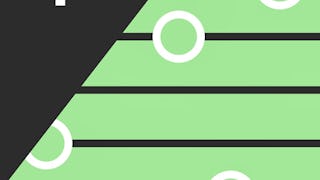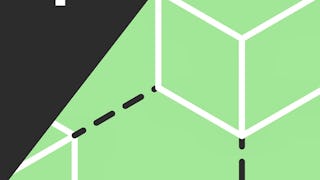This intermediate-to-advanced course guides learners through the structured development of procedural surface systems in Unity using noise-based methods. Through six focused modules, participants will explore dimensional noise functions, gradient masks, resolution control, derivative computation, and flow visualization using particle systems and scripting.

Découvrez de nouvelles compétences avec 30 % de réduction sur les cours dispensés par des experts du secteur. Économisez maintenant.


Unity: Design Procedural Surfaces with Noise Functions
Ce cours fait partie de Spécialisation Unity Procedural Generation & Game Mechanics

Instructeur : EDUCBA
Inclus avec 
Compétences que vous acquerrez
- Catégorie : Computer Graphics
- Catégorie : Virtual Reality
- Catégorie : Real Time Data
- Catégorie : Simulations
- Catégorie : Visualization (Computer Graphics)
- Catégorie : Computer Graphic Techniques
- Catégorie : Unity Engine
- Catégorie : Scripting
Détails à connaître

Ajouter à votre profil LinkedIn
août 2025
18 devoirs
Découvrez comment les employés des entreprises prestigieuses maîtrisent des compétences recherchées

Élaborez votre expertise du sujet
- Apprenez de nouveaux concepts auprès d'experts du secteur
- Acquérez une compréhension de base d'un sujet ou d'un outil
- Développez des compétences professionnelles avec des projets pratiques
- Obtenez un certificat professionnel partageable

Il y a 6 modules dans ce cours
This module introduces learners to the foundational concepts and practical setup for procedural noise generation in Unity. It covers the theory of noise, setting up a visual platform using quads, interfacing with the Texture Creator script via the Inspector, and understanding wrap modes. It also delves into how spatial transformations and resolution settings influence texture output and how deterministic methods like value duplication can ensure consistent sampling. By the end of this module, learners will have built the groundwork for more advanced procedural content systems by manipulating and configuring 2D texture behaviors programmatically.
Inclus
7 vidéos3 devoirs
This module introduces flexible programming constructs and foundational techniques for generating procedural noise in Unity. It begins with the use of delegates to abstract and pass custom noise functions dynamically, enabling modularity and reusability. Learners explore how to structure 2D and 3D float-returning functions to generate procedural values. The module then builds toward implementing Perlin noise and customizing value methods, culminating in the use of gradient masks to shape surface influence. These techniques provide the backbone for flexible, scalable procedural content systems that respond to both spatial and runtime dynamics.
Inclus
6 vidéos3 devoirs
This module focuses on customizing the spatial characteristics and complexity of procedural textures in Unity by manipulating texture dimensions, frequency, and layered noise. Learners will explore how to define texture resolutions, apply both 2D and 3D gradient masks for localized control, and refine procedural results through frequency scaling. The module concludes with the use of octaves to layer multiple noise functions for more realistic and organic outcomes, culminating in the creation of an isolated surface scene for controlled testing and visualization of procedural systems.
Inclus
5 vidéos3 devoirs
This module guides learners through the construction and refinement of procedural surfaces using Unity’s mesh manipulation and noise application systems. It covers how to generate a custom mesh grid, apply noise to create terrain-like displacement, and fine-tune results through parameters such as resolution, strength, and offset. Learners will also implement responsive update mechanisms using refresh methods, allowing real-time control and visualization of procedural changes. By the end of this module, learners will have built a flexible and adjustable system for generating dynamic surfaces in 3D space.
Inclus
6 vidéos3 devoirs
This module introduces the concept of sampling and derivatives in procedural noise systems to enhance visual detail and control in surface generation. Learners will explore how to extract directional information from noise fields, encapsulate both values and gradients using custom data structures, and implement static and dynamic noise samples for debugging and consistency. The module further covers how derivatives are computed for both value and Perlin noise, including the use of analytical methods to efficiently derive slope and flow characteristics in 2D and 3D spaces.
Inclus
6 vidéos3 devoirs
This module focuses on converting procedural noise data into dynamic visual representations by integrating flow fields, derivative smoothing, and particle systems. Learners will validate noise type compatibility, smooth derivative transitions to improve surface continuity, and build flow visualization components that convey direction and intensity using visual elements. Through the use of particle trails, GameObjects, and scripting, the module teaches how to express flow dynamics in 3D environments using Unity’s rendering and scripting systems.
Inclus
6 vidéos3 devoirs
Obtenez un certificat professionnel
Ajoutez ce titre à votre profil LinkedIn, à votre curriculum vitae ou à votre CV. Partagez-le sur les médias sociaux et dans votre évaluation des performances.
En savoir plus sur Design and Product

Coursera Project Network
 Statut : Prévisualisation
Statut : PrévisualisationThe University of Tokyo
 Statut : Essai gratuit
Statut : Essai gratuit
Pour quelles raisons les étudiants sur Coursera nous choisissent-ils pour leur carrière ?





Ouvrez de nouvelles portes avec Coursera Plus
Accès illimité à 10,000+ cours de niveau international, projets pratiques et programmes de certification prêts à l'emploi - tous inclus dans votre abonnement.
Faites progresser votre carrière avec un diplôme en ligne
Obtenez un diplôme auprès d’universités de renommée mondiale - 100 % en ligne
Rejoignez plus de 3 400 entreprises mondiales qui ont choisi Coursera pour les affaires
Améliorez les compétences de vos employés pour exceller dans l’économie numérique
Foire Aux Questions
To access the course materials, assignments and to earn a Certificate, you will need to purchase the Certificate experience when you enroll in a course. You can try a Free Trial instead, or apply for Financial Aid. The course may offer 'Full Course, No Certificate' instead. This option lets you see all course materials, submit required assessments, and get a final grade. This also means that you will not be able to purchase a Certificate experience.
When you enroll in the course, you get access to all of the courses in the Specialization, and you earn a certificate when you complete the work. Your electronic Certificate will be added to your Accomplishments page - from there, you can print your Certificate or add it to your LinkedIn profile.
If you subscribed, you get a 7-day free trial during which you can cancel at no penalty. After that, we don’t give refunds, but you can cancel your subscription at any time. See our full refund policy.
Plus de questions
Aide financière disponible,


